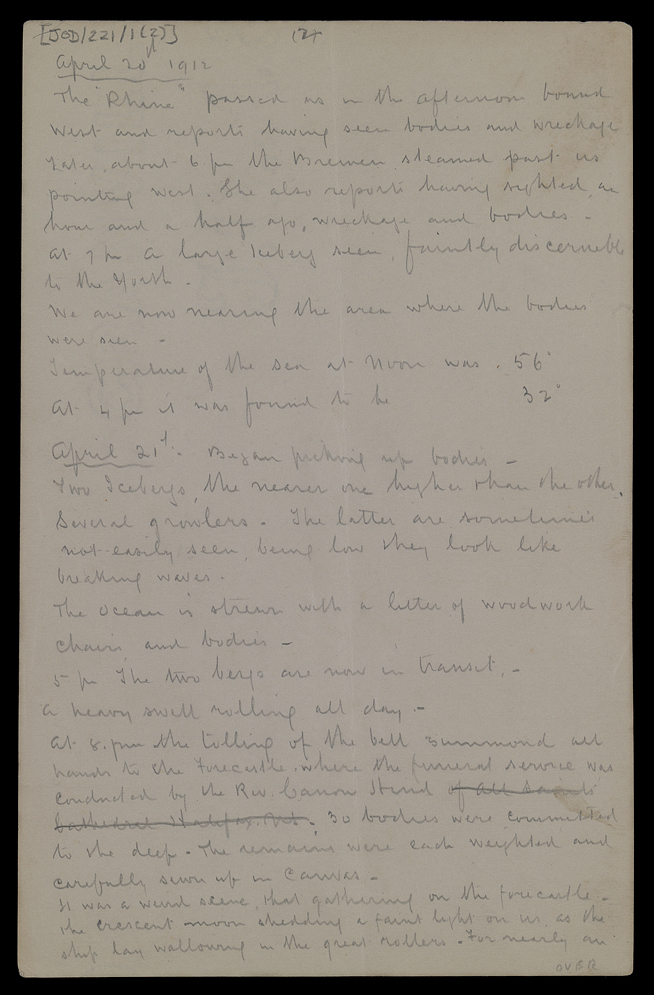Your cart is currently empty!
The ocean is strewn with a litter of woodwork, chairs and bodies

© National Maritime Museum, Greenwich, London
On the fateful morning of 21st April 1912, cable engineer Frederick A. Hamilton steeled himself for a harrowing task. Six days earlier, the RMS Titanic had met its doom, striking an iceberg and plummeting to the depths, taking with it over 1,500 passengers and crew members in one of history’s most devastating peacetime maritime disasters. The CS Mackay-Bennett was the first recovery ship to reach the scene, and it arrived with 100 coffins, 100 tons of ice, and embalming supplies for a mere 70 bodies; a week later, despite the immense weight of the tragedy, the crew had managed to recover 306 bodies, 116 of which were wrapped up and buried at sea. Hamilton, one of those 75 dedicated crew members, documented his experience on that first day in his diary.
The Diary Entry
April 21st. Began picking up bodies –
Two icebergs, the nearer one higher than the other. Several growlers. The latter are sometimes not easily seen, being low they look like breaking waves.
The ocean is strewn with a litter of woodwork, chairs and bodies –
5pm The two bergs are now in transit – a heavy swell rolling all day.
At 8.pm the tolling of the bell summoned all hands to the forecastle where the funeral service was conducted by the Rev. Canon Hind. 30 bodies were committed to the deep. The remains were each weighted and carefully sewn up in canvas –
It was a weird scene, that gathering on the forecastle – the crescent moon shedding a faint light on us as the ship lay wallowing in the great rollers. For nearly an hour the words “For as much as it hath pleased Almighty God to take unto himself the soul of our dear brother here departed we therefore commit his body to the deep” were repeated and at each interval came splash as the weighted body plunged into the sea there to sink to a depth of about two miles –
Further Reading
Frederick A. Hamilton’s original diary now lives at the National Maritime Museum in Greenwich, London. Reproduced here with permission. This particular entry has been quoted in various books over the years, but it always seems embellished—usually starting, for example, with the more evocative line: “Two icebergs now clearly in sight, the nearest is over a hundred feet high at the tallest peak, and an impressive sight, a solid mass of ice, against which the sea dashes furiously, throwing up geyser like columns of foam…” This wording is not in the manuscript held at NMN. Maybe there’s another diary of his somewhere, or maybe he rewrote and expanded it after the event for publication. I’m unsure. For now, though, I’m sticking with the handwritten version, which I’ve transcribed directly.
Make a Donation
If you’re able, please consider supporting Diaries of Note with a donation.
One response to “The ocean is strewn with a litter of woodwork, chairs and bodies”
-
The preceding entry at the top of the page is equally interesting:
April 20, 1912
The “Rhine” passed us in the afternoon bound
west and reported having seen bodies and wreckage.
Later, about 6 pm the Bremer steamed past us
pointing west. She also reported having sighted one
hour and a half ago, wreckage and bodies.
At 7 pm a large iceberg seen, faintly discernible
in the North.
We are now nearing the area where the bodies
were seen.
Temperature of the sea at noon was 56 °
At 4 pm it was found to be 32 °

Leave a Reply to Bob Morrison Cancel reply